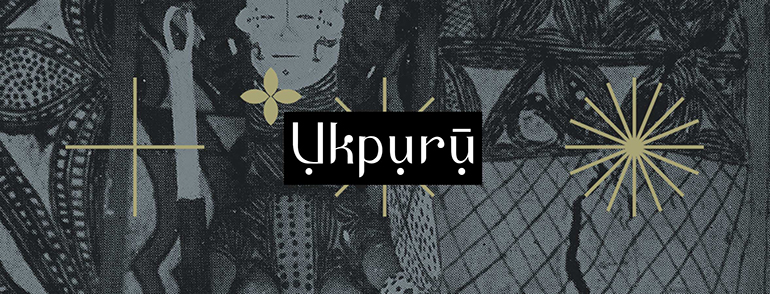
"Play of late Chief Ogolo of Opobo - men dressed in ritual costumes." photographed by Arthur Tremearne, c. 1913. MAA Cambridge.
These appear to be Ọ̀kọnkọ̀ masks which is the Ekpe society over the eastern part of the delta including present-day Abia, Imo, and Rivers State. It was spread by the Aro people as a way of securing commercial ties on trade routes (including the slave trade). The mask on the extreme right is known in the Igbo hinterland as Ohu ebì meaning porcupine quills.
 Ohu ebì, an Ọ̀kọnkọ̀ mask used throughout the south central and eastern part of the Igbo country and the delta.
Ohu ebì, an Ọ̀kọnkọ̀ mask used throughout the south central and eastern part of the Igbo country and the delta.
Societies like Ọ̀kọnkọ̀ in the southern Igbo area are part of àbàràm̀àba, the different societies a man especially may enter to expand their knowledge, trading ties and prestige; knowledge, like that of Ekpe-related nsibiri, and titles had to be purchased. Ọ̀kọnkọ̀ acted as a judicial authority before colonial conquest in these areas where centralised authority like Eze or Obi were largely absent or symbolic like in case of the Aro. The name appears to have come from an Ekpe mask.
With the Igbo east of the Niger, there's a rough split culturally between north and south, especially southeast. Towards the south some of the stereotypical cultural elements of Igbo people, mmanwu, Ikenga, Ozo na Nze (red caps), Ogene genre, etc. are faint or completely absent. It often means Umuahia groups for example can share a lot of culture with Opobo for instance that they do not with Onicha. The cultural continuum to the south blends into the delta areas (like Kalabari) with dialect, dance, dressing, music, etc.
One of the major differences is that the stratified system based on priests in some areas to the north like Nri, is completely absent in the south and is replaced by rich titled men and men's societies like Ekpe and Okonko which were borrowed from the Cross River. This is related to the two main areas of origin for most Igbo groups which is the Nri-Öka area and the Nkwere-Ölü area. With the solidification of pan-ethnic identity, and influence of colonial policy, you might now see monarchical systems like Eze to the south and people wearing red caps, but these things are not part of the core culture.

No comments:
Post a Comment